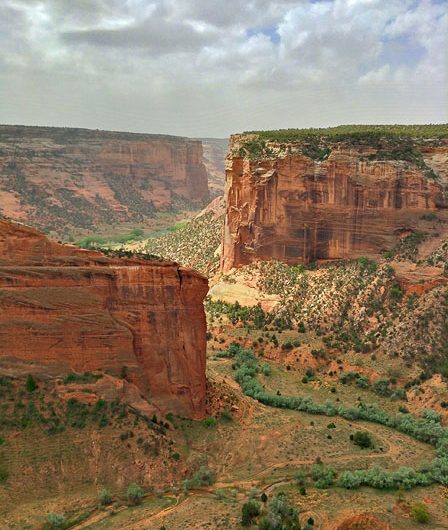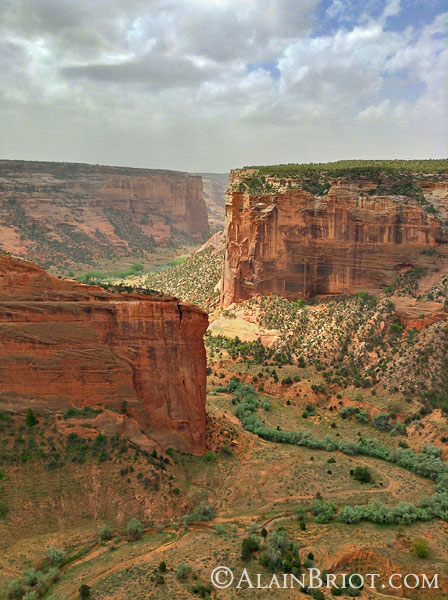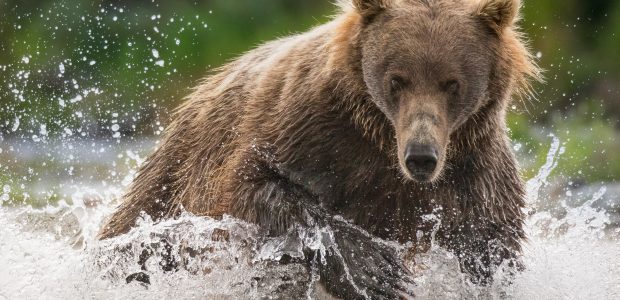

by Alain Briot
The way to get out of photographer’s block is to simply place some constraints on yourself.
Austin Kleon
1 – Introduction
Expressing our vision hinges on our abilities to be both creative and productive. Both are possible only if we experience a state of flow, what is often referred to as ‘being in the groove.’ It is when we are in such a state that we are at our peak in terms of expressing our inner feelings and emotions and translating them into our work.
I cover this subject in detail in the essay titled ‘flow’ in the Personal Vision Mastery Workshop on DVD. My goal in the essay you are reading now is to talk about the opposite of flow.
The opposite of flow is blockage. We have all experienced blockage: a state in which we feel totally unable to produce anything, let alone feel creative in any way.
There are several different types of blockages and this is why I used blocks and not block in the title of this essay. My goal here is to cover what these blockages are and offer solutions and advice to prevent or remedy them.
2 – Possibilities can be limiting
Having a multitude of possibilities is just as limiting as having no possibilities at all. If you can do anything, what do you do? If you can do nothing, what do you do? The question you have to answer is the same. Eventually you only need to do one thing. Not a million, and not zero, just one thing but the right thing, the one that inspires you, the one that fosters your vision.
Personally, I realized that working with digital photography effectively meant setting some limitations otherwise the infinite possibilities it offered would shut me down. Faced with being able to do anything, I would end up wandering from one thing to the next endlessly, exploring countless creative possibilities but unable to do meaningful work.
So for my work I selected a set of tools that I particularly like and I designed a workflow that allowed me to be creative and achieve my vision in the style that I liked. From there, once this had been done, I changed very little to this approach in the next four years. In fact I changed very little in the next 10 years. All I did was add a few new tools that had useful features and change a few things because improved versions came out. By doing so I put limits on what I did and I was able to focus on my creativity rather than on the constant stream of new software features. I was able to focus on my work and on my artistic goals, not on my tools.
Over the years, while those tools and software have remained essentially the same, my work has evolved and grown. If I had not placed these limitations on myself I believe that my work would have stagnated while my tools and software would have constantly changed. We cannot do everything at once. We have to limit ourselves. The decisions we make must be taken so as to allow us to focus on what matters most, and in my estimate this is the vision we have for our work.
3 – Copy others
The traditional way of learning art has been to copy the masters. Today we continue this tradition by being inspired by the work of photographers we like and by trying to create images similar to theirs.
Artists are sometimes concerned with the implications that come with copying someone else’s work. They believe that copying someone’s work means that they can never develop their own style and vision.
This can certainly be a risk if you copy someone else’s work blindly your whole life. But if you take someone’s work as a point of departure and an inspiration, this fear is not justified.
The reason why it is not justified is because we can never truly copy anyone. At best we can be inspired by it and come close to the results achieved by the master we are trying to emulate. The minute we ‘copy’ someone’s work we put our own twist to it and it becomes ours. If we continue this approach over a long time we will end up developing our own style and expressing our own vision. Of course the process is more complex than that and describing it in details is the purpose of the Personal Vision Mastery Workshop on DVD.
Don’t be afraid of being accused of making copies of someone else’s work. As long as you don’t pass their work for yours, the images you create are your original work. Plus, as we just saw, you can never truly copy someone else’s work.

Canyon de Chelly
Limiting yourself to a simple camera can have a freeing effect. I took this photograph with my iPod touch.
This was the only camera I used during this trip. Its use resulted in images that are different from the ones I usually take. It also gives me ideas for using new colors and contrast levels.
You cannot be creative in a non-inspiring environment. This environment can be anything you want, it can be your studio, your backyard, the town you live in, or the state or geographical area of your choice.
Clearly this depends on the subject you photograph. However, for landscape photographers it is the landscape that first and foremost our environment. Afterwards, it is our studio, the place where we process and print our photographs.
For me Canyon de Chelly was such an environment and it played a key role in getting me unblocked and starting my photography career. This is why thee photographs i selected for this essay are all from Canyon de Chelly.

Canyon de Chelly
5 – Be enthusiastic
Enthusiasm is being sold out about something, in this case about doing photography.
An important aspect of being enthusiastic is finding enjoyment in your work. You are doing this because you want to, not because you have to, so if doing photography is not pleasurable then something is going wrong.
6 – Be curious
Find a subject that intrigues you but that you have not photographed before and investigate its possibilities with your camera.
Explore a new subject. If you always photograph landscapes, photograph people for a while. If you always photograph people photograph landscapes. Whatever the case might be, find a subject that is new to you and attractive and see what you can do with it.
7 – Don’t let negative opinions cut you down
The main hurdle to creative expression is fear of criticism. The solution to this hurdle is learning how to understand criticism. I cover this subject in depth in my Personal Style Mastery Workshop on DVD. Below are some of the tips I share in the DVD:
– Seek the company of people who like your work and encourage you to go further with it
– Build your self esteem and confidence by showing your work to people who like it and provide compliments and offer constructive criticism. Having an audience that understands your work and supports your efforts will protect you from the onslaught of naysayers, self-doubt generators, sell-esteem destroyers, constant-critics and other negatively–minded individuals.
– Don’t listen to the naysayers. Just because someone says you cannot do something does not mean they are right. To stop doing what you like because of someone’s comment is giving them more credit than they deserve.

Lucy, Navajoland
8 – Find your vision
Finding your vision means clarifying what you want to say and how you want to say it. Knowing this leads to an easier and more intuitive approach to subject and technique selection
Much of what we call ‘artist block’ comes from not knowing which path or which direction to take. Vision is setting this path and thereby removing one of the photographers blocks.
Having a vision is important. By definition is it a projection towards the future, a goal you want to reach, a guiding light. Without vision you are left wandering in the dark, your creativity and motivation affected by new gear, techniques and locations rather than by a deep rooted conviction in your purpose for taking photographs.
9 – Skill enhancement exercises
Below are several skill enhancement exercises designed to help you practice the advice in this essay:
A -Leave something out
– Leave something out deliberately
– Leave everything out except one thing
B – Place constraints on yourself
– Photograph with just your Phone or tablet
– Take only one photograph each day and try to make it a world class image
– Use only four colors in your photographs
– Use only two colors in you photographs
C – Photograph only one subject
– Water towers
– Three legged dogs,
– Green wheelbarrows
– Landscapes with 4 trees
– Rocks split in half
– Trees with branches only on one side
– etc.
D – Copy someone’s work
Find an artist whose work you like and create images that are as close to this artist’s work as you can possibly make them. Don’t be afraid of being accused of making copies of this person’s work. As long as you don’t pass their work for yours, the images you create are your original work. Plus, as we saw in section three, you can never truly copy someone else’s work.
10 – Conclusion
Personally one of the best solutions to photographers’ blocks is to go to a place I really like. Once there I may feel like taking photographs or I may not, but being there is the best way to get me going again. The place infuses its energy into me, and this energy motivates me to create images, to make photographs.
Eventually photographers’ block is nothing more than mental, physical and especially creative exertion. You need creative rest to fix the problem. The last thing you need is wreak your brain trying to figure out how to be creative again. Instead of staring at the blank computer screen, or the empty camera LCD screen or viewfinder trying to find something to photograph, go to a place you love, relax and enjoy being there, waiting for the muses to visit.
It’s also helpful to shift our focus from product to process. This means replacing the desire to create a stunning image with the desire to enjoy the process of creating images, be they good or great or not so great. The goals is to enjoy what you do because when you do that you invite creativity in your life and push photographer’s blocks away.
11 – About Alain Briot
I create fine art photographs, teach workshops and offer DVD tutorials on composition, image conversion, optimization, printing and marketing. I am the author of Mastering Landscape Photography, Mastering Photographic Composition, Creativity and Personal Style and Marketing Fine Art Photography. All 3 books are available in eBook format on my website at this link: http://beautiful-landscape.com/Ebooks-Books-1-2-3.html

Printed books Link
eBooks link
You can find more information about my work, writings and tutorials as well as subscribe to my Free Monthly Newsletter on my website at http://www.beautiful-landscape.com . You will receive 40 free eBooks immediately after subscribing.
I welcome your comments on this essay as well as on my other essays. You can reach me directly by emailing me at alain@beautiful-landscape.com.
Alain Briot
Arizona
November 2014

Lorem ipsum dolor sit amet, consectetur adipiscing elit, sed do eiusmod tempor incididunt ut labore et dolore magna aliqua. Ut enim ad minim veniam, quis nostrud exercitation ullamco laboris nisi ut aliquip ex ea commodo consequat. Duis aute irure dolor in reprehenderit in voluptate velit esse cillum dolore eu fugiat nulla pariatur. Excepteur sint occaecat cupidatat non proident, sunt in culpa qui officia deserunt mollit anim id est laborum.
Lorem ipsum dolor sit amet, consectetur adipiscing elit, sed do eiusmod tempor incididunt ut labore et dolore magna aliqua. Ut enim ad minim veniam, quis nostrud exercitation ullamco laboris nisi ut aliquip ex ea commodo consequat. Duis aute irure dolor in reprehenderit in voluptate velit esse cillum dolore eu fugiat nulla pariatur. Excepteur sint occaecat cupidatat non proident, sunt in culpa qui officia deserunt mollit anim id est laborum.
You May Also Enjoy...
Alaska and The Brown Bears, Emerging Photographer, Benjamin Olson
FacebookTweet Benjamin Olson Art Wolfe Next-Generation Nature Photographers Grant Alaska and The Brown Bears As a young nature photographer, I have always found difficulty finding

